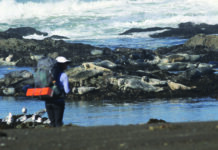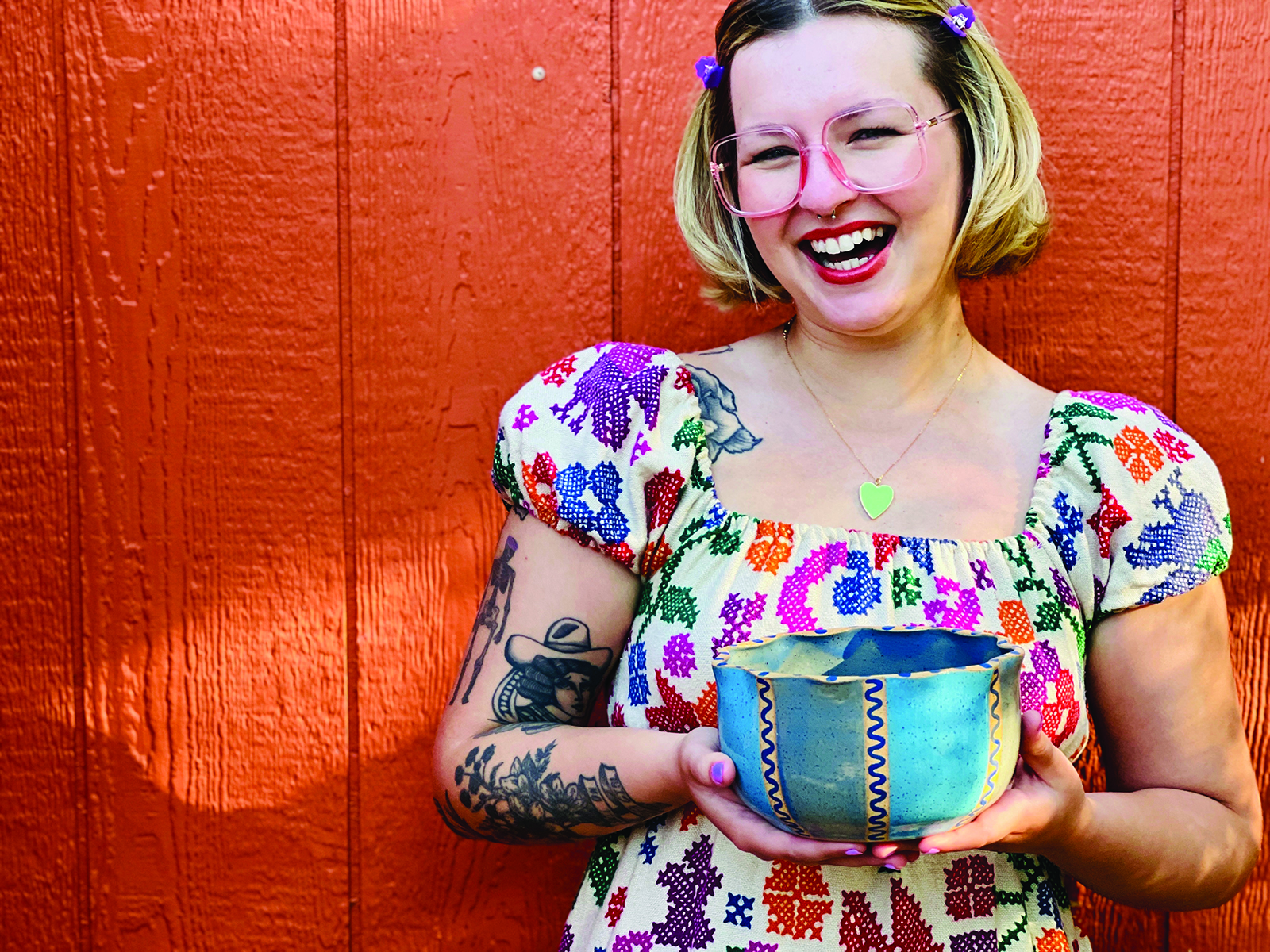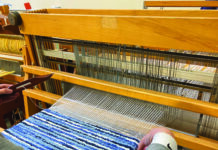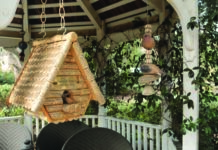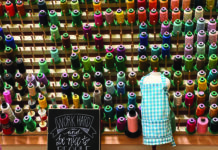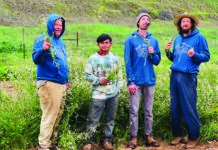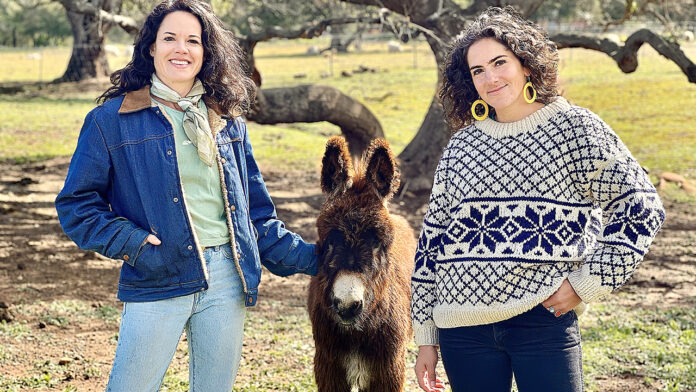
Shepherdess Land and Livestock integrates land management with sustainable wool production.
By Nancy D. Lackey Shaffer | Photos by Viktor Budnik
Wide open skies. Rolling hills softened by velveteen carpets the color of emeralds. Oak trees, the Topatopa Mountains and a brisk, frigid, but exceptionally fresh wind blowing through it all. There’s no place quite like Upper Ojai in winter.
Making themselves at home in this bucolic setting are wooly sheep, some with lambs underfoot, and a playful donkey colt antagonizing his patient mother. A white and brown dairy goat with her black-as-night billy hold court while two horses graze in the distance. Two dogs, a few cats, and a rustic home with a wide porch complete the picture of pastoral bliss.
Welcome to the 240-acre ranch of Brittany Cole Bush, known in the sheep herding community as Cole the Shepherdess. The ranch serves as the base of operations for her company, Shepherdess Land and Livestock, which she opened in 2020.
The lands on which this shepherdess operates go far beyond her ranch, however, and its resident animals are only a small part of the larger “flerd” she manages. Bush has around 550 sheep (the flock) and 150 goats (the herd) which she uses for what is known in the agricultural industry as “targeted grazing”: using livestock to address a variety of land management issues. Her mixed group of ruminants spend eight months of the year on the properties, mainly in the Ojai Valley and in Northern Los Angeles County, where they are employed to help remove invasive plants, reduce wildfire risk, control weeds and even increase soil fertility. Shepherdess Land and Livestock is one of dozens of outfits in California (Cuyama Lamb in Santa Barbara County is another, one which with Bush collaborates) with “herds for hire” for targeted grazing.
But here in Upper Ojai, she is beginning to embark on a new, smaller, but very special endeavor: wool that comes from animals raised close to home.
“Wool is part of our ethos: Mindful sourcing of things that come from animals,” Bush explains.
A Brief History of Wool
Wool may not be the first textile used by humans — that distinction probably goes to linen, made from flax — but it’s close. According to the Brussels-based International Wool Textile Organization, “Humans have been washing, weaving, and wearing wool since 10,000 BCE.” Czech textile manufacturer Sartor Bohemia states that wool textiles date from about the fourth millennium BCE while the American Wool Council notes that by 3000 BC, wool was being distributed throughout Europe by Persians, Greeks and Romans. Through the centuries, it has been woven, worn, traded and transported across the globe, giving rise to major wool centers in Australia and New Zealand, England and Scotland, Argentina, Turkey, China and even here in the USA.
California’s own wool industry grew as the Gold Rush brought 49ers west. Warm, durable, water-resistant wool was a popular fabric for people living and working in the foothills of the Sierra Nevada Mountains, and the growing demand meant more sheep (brought over from the Southwest, another major wool producing region), shepherds and mills. The California Wool Growers Association was founded in 1860 and is possibly the oldest agricultural organization in the state.
Wool was used heavily in all manner of clothing during the following decades, particularly in the construction of military uniforms. Following World War II and the Korean War, there was a marked decrease in wool availability. In order to bolster the declining wool industry, Congress passed the National Wool Act of 1954, offering price support to sheep producers based on a percentage of their market sales.
Around the same time, however, cheaper synthetic fibers like nylon, polyester and acrylic were coming onto the market. U.S. wool production continued to decline and commodity programs for wool and mohair ceased in 1995.
Despite the decline, the United States remains one of the largest wool-producing countries in the world. Around 22 million pounds of greasy (i.e. uncleaned) wool was produced in 2022, as reported by the USDA’s National Agricultural Statistics Service. And of that, around 2.2 million pounds came from California, the second largest producer of domestic wool in the nation. Much of that is exported to China, where it’s processed and turned into textiles and apparel…that end up getting imported back into the U.S.
American wool producers are making an effort to change that, and they’re getting a boost from consumers’ growing concern for sustainability and buying local. Just as the farm-to-table concept has bolstered homegrown food production and encouraged more environmentally friendly growing practices, consumers, manufacturers and artisans are driving the demand for eco-conscious domestic fiber production…including wool.
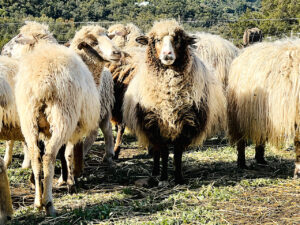
A Heritage Breed
Shepherdess Land and Livestock is new to the wool game, and Bush is being mindful in her approach. She acquired her first wool flock in the summer of 2022, selecting a breed strongly tied to the Native American cultures of the Southwest: the Navajo-Churro.
Navajo-Churro sheep are descended from an ancient Iberian breed, the Churra, brought to North America by Don Juan de Oñate in 1598. Over time the Navajo and Pueblo people acquired and nurtured their own herds, using its lustrous, silky wool for their woven blankets and rugs.
Bush learned about the breed after attending the Sheep Is Life Festival in Arizona, and getting to know a Navajo shepherd.
“He had introduced me to folks in his clan and family group,” she explains. “It’s taken me some time to source these beautiful animals. I wanted to be mindful and respectful of not just ‘buying’ these sheep but to help preserve and protect the breed.”
She started with 13 head — 11 ewes and two rams. Four lambs have been born since. The first shearing took place over the winter.
“To have them in our valley is really quite special,” says Bush. “It’s an honor to have this threatened breed.”
The Terroir of Textiles
Integral to Shepherdess Land and Livestock’s journey into wool is shepherd, ranch manager and program manager Diane Anastasio.
“What brought Diane to our work was through the fiber aspect of what we do,” says Bush.
A native of Connecticut, Anastasio went to college in New York City and graduate school in London.
“I was a city person for many years,” she says. “I had many lives…I never thought I’d live in a rural place again.”
After developing some health problems, she got interested in nutrition, which eventually led her to livestock.
“I got interested in food systems and how people can eat meat in a way that’s healthy for us, the animals and the land.”
She spent time shepherding in the Austrian Alps and Wales, and learned that “fiber was important to me. Terrior, the aspect of wool and fiber and traceability…having a piece of clothing rooted to a particular place. I was hooked after that.”
After returning to the U.S., she learned to shear sheep at the University of California’s Hopland Research and Extension Center in Mendocino County, an agriculture education facility that has a historical sheep station onsite. She also took up weaving.
Her experience with many aspects of managing sheep, including building fences on steep hillsides, made Anastasio uniquely qualified to help Bush with her fiber flock. She joined Shepherdess Land and Livestock in August 2022.
“I wanted to be with the animals,” she said. “I jumped at the chance to work with Cole.”
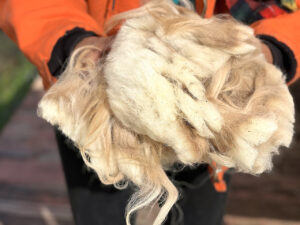
Threads Coming Together
They’re still at the start of their wooly adventure, but Bush and Anastasio have ambitious plans.
“We’re at the first steps of getting our [fiber] program established,” Bush explains. “Bringing consciousness to artisans and our community [about fiber sources]. We’re learning about the breed of the sheep and how we can best integrate fiber into the valley.”
The first shearing of the Navajo-Churro sheep yielded over 70 pounds of wool, which will be sent out to be processed for a variety of projects: weaving yarn for rugs (both Bush and Anastasio are enthusiastic weavers), a felting project being developed with a Los Angeles fiber artist, possibly a natural dye workshop and the planting of a dye garden.
Grazing animals, properly managed, can improve soil density and structure. A program under development, Wild Wool Flowers, involves planting flower seeds in areas where the Navajo-Churro sheep have grazed.
Another idea is aimed at the textile industry. Bush would like to invite representatives from large clothing brands to learn about ways to bring “more sustainable materials into brand production.”
“It’s important for these big brands to know what it takes,” she says.
That means understanding the full cycle of wool, which goes far beyond raising and shearing sheep. There’s all the processing wool requires: scouring, sorting, milling, spinning and finishing. The scarcity of wool mills in the U.S. limits what can be used domestically. Bush would like to see big brands leading the charge to bring the wool industry back to the U.S.
“It’s not just about producing wool,” she explains. “It’s also about job growth. Raising sheep holistically will bring sustainable wool production back to the United States, and the industry involved in all aspects of it, offers opportunities for employment.”
A Shepherding Culture
Wool doesn’t end with shepherding, of course, but a robust domestic wool industry will have at its foundation people who know how to raise, herd, shear and manage sheep. Key to that, in Bush’s opinion, is the re-creation of “a shepherding culture.” To that end, Bush participates in a rigorous training and education program, offered by the Grazing School of the West, to teach a new generation of shepherds through apprenticeships, bootcamps and workshops.
“We need more sheep, shepherds and people buying wool,” Bush says simply. “More knowledge and skill — shepherding is a lost art that needs to be reinvigorated.”
Anastasio sees the interconnectedness of the company’s targeted grazing operation — Shepherdess Land and Livestock’s main focus — with ecological health and sustainable wool production.
“Wool is a renewable resource,” she says. “Humans have had a relationship with sheep for thousands of years. This is what sustainability is. When sheep are managed properly, they’re good for the land. There are so many ways we can all benefit.”
Shepherdess Land and Livestock
805.705.3084




